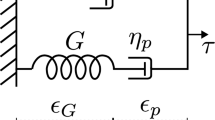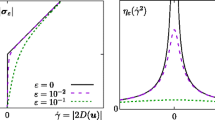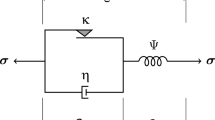Abstract
A novel variant of the Material Point Method is proposed to solve flow problems for incompressible viscoelastic fluids. As in the original spirit of the method, material points possess all necessary information about the material constitutive behavior and move with the flow. They are additionally employed as integration points, whose weights are computed as the system evolves in order to ensure exact integration of the discretized conservation equations. The method is shown to achieve quadratic convergence for transient start-up flow of the Oldroyd-B fluid. In addition, we apply the method to flow of a Giesekus fluid in concentric rotating cylinders, and in flow through an abrupt 4:1 contraction, comparing favorably to available analytical, experimental, and simulation results as appropriate.













Similar content being viewed by others
References
Azaiez J, Guenette R, Ait-Kadi A (1996) Entry flow calculations using multi-mode models. J Non-Newton Fluid Mech 66(2–3):271–281
Azaiez J, Guenette R, Ait-Kadi A (1996) Numerical simulation of viscoelastic flows through a planar contraction. J Non-Newton Fluid Mech 62(2–3):253–277
Baiijens F (1998) Mixed finite element method for viscoelastic flow analysis: a review. J Non-Newton Fluid Mech 79:361–385
Bird RB, Armstrong RC, Hassager H (1987) Dynamics of polymeric liquids volume 1: fluid mechanics. Wiley, New York
Chaniotis A, Poulikakos D, Koumoutsakos P (2002) Remeshed smoothed particle hydrodynamics for the simulation of viscous and heat conducting flows. J Comput Phys 182(1):67–90
Coronado OM, Arora D, Behr M, Pasquali M (2007) A simple method for simulating general viscoelastic fluid flows with an alternate log-conformation formulation. J Non-Newton Fluid Mech 147(3):189–199
Duarte ASR, Miranda AIP, Oliveira PJ (2008) Numerical and analytical modeling of unsteady viscoelastic flows: the start-up and pulsating test case problems. J Non-Newton Fluid Mech 154(2–3):153–169
Ellero M, Tanner R (2005) SPH simulations of transient viscoelastic flows at low Reynolds number. J Non-Newton Fluid Mech 132:61–72
Ellero M, Kroger M, Hess S (2002) Viscoelastic flows studied by smoothed particle hydrodynamics. J Non-Newton Fluid Mech 105:35–51
Feldman J, Bonet J (2007) Dynamic refinement and boundary contact forces in SPH with applications in fluid flow problems. Int J Numer Methods Eng 72(3):295–324
Feng H, Andreev M, Pilyugina E, Schieber J (2016) Smoothed particle hydrodynamics simulation of viscelastic flows with the slip-link model. Mol Syst Des Eng 1:99–108
Gallez X, Halin P, Lielens G, Keunnings R, Legat V (1999) The adaptive lagrangian particle method for macroscopic and micro-macro computations of time-dependent viscoelastic flows. Comput Methods Appl Mech Eng 180:345–364
Guenette R, Fortin M (1995) A new mixed finite element method for computing viscoelastic flows. J Non-Newton Fluid Mech 60:27–52
Halin P, Lielens G, Keunnings R, Legat V (1998) The lagrangian particle method for macroscopic and micro-macro viscoelastic flow computations. J Non-Newton Fluid Mech 79:387–403
Hua C, Schieber JD (1996) Application of kinetic theory models in spatiotemporal flows for polymer solutions, liquid crystals and polymer metls using the CONNFFESSIT Approach. Chem Eng Sci 51(9):1473–1485
Hulsen M, Fattal R, Kupferman R (2005) Flow of viscoelastic fluids past a cylinder at high weissenberg number: stabilized simulations using matrix logarithms. J Non-Newton Fluid Mech 127(1):27–39
Idelsohn S, Nigro N, Limache A, Onate E (2012) Large time-step explicit integration method for solving porlbmes with dominant convection. Comput Methods Appl Mech Eng 217–220:168–185
Kane A, Guenette R, Fortin A (2009) A comparison of four implementations of the log-conformation formulation for viscoelastic fluid flows. J Non-Newton Fluid Mech 164(1–3):45–50
Laso M, Öttinger H (1993) Calculation of viscoelastic flow using molecular models: the CONNFFESSIT approach. J Non-Newton Fluid Mech 47:1–20
Lastiwka M, Quinlan N, Basa M (2005) Adaptive particle distribution for smoothed particle hydrodynamics. Int J Numer Meth Fluids 47:1403–1409
Lewis R, Ravindran K, Usmani A (1995) Finite element solution of incompressible flows using and explicit segregated approach. Arch Comput Methods Eng 2:69–93
McKinley G, Pakdel P, Oztekin A (1996) Rheological and geometric scaling of purely elastic flow instabilities. J Non-Newton Fluid Mech 67:19–47
Moresi L, Dufour F, Muhlhaus HB (2003) A lagrangian integration point finite element method for large deformation modeling of viscoelastic geomaterials. J Comput Phys 184:476–497
Nithiarasu P (2004) A fully explicit characteristic based split (cbs) scheme for viscoelastic flow calculations. Int J Numer Methods Eng 60(5):949–978
O’Neill C, Moresi L, Muller D, Albert R, Dufour F (2006) Ellipsis 3D: a particle-incell finite element hybrid code for modeling mantle convection and lithospheric deformation. Comput Geosci 32:1769–1779
Press W, Flannery B, Teukolsky S, Vetterling W (1986) Numerical recpies: the art of scientific computing, 1st edn. Cambridge University Press, Cambridge
Quinzani L, Armstrong R, Brown R (1994) Birefringence and laser-doppler velocimetry (ldv) studies of viscoelastic flow-through a planar contraction. J Non-Newton Fluid Mech 52(1):1–36
Ravanchi MT, Mirzazadeh M, Rashidi F (2007) Flow of giesekus viscoelastic fluid in a concentric annulus with inner cylinder rotation. Int J Heat and Fluid Flow 28(4:SI):838–845
Shaqfeh E (1996) Purely elastic instabilities in viscometric flows. Annu Rev Fluid Mech 28:129–185
Sulsky D, Chen Z, Schreyer H (1994) A particle method for history-dependent materials. Comput Methods Appl Mech Eng 118:179–196
Sulsky D, Zhou SJ, Schreyer H (1995) Application of a particle-in-cell method to solid mechanics. Comput Phys Commun 87:236–252
Wapperom P, Keunnings R, Legat V (2000) The backward-tracking lagrangian particle method for transient viscoelastic flows. J Non-Newton Fluid Mech 91:273–295
Waters N, King M (1970) Unsteady flow of an elastico-viscous liquid. Rheol Acta 9(3):343–55
Xue S, Tanner R, Phan-Thien N (2004) Numerical modelling of transient viscoelastic flows. J Non-Newton Fluid Mech 123(1):33–58
Yoo J, Choi H (1989) On the steady simple shear flows of the one-mode giesekus fluid. Rheol Acta 28(1):13–24
Acknowledgements
We gratefully acknowledge ExxonMobil Research & Engineering for support of and permission to publish this work. The authors also thank Ron Larson (U. Michigan) and Jay Schieber (Illinois Institute of Technology) for helpful discussions and suggestions throughout this work.
Author information
Authors and Affiliations
Corresponding author
Ethics declarations
Conflict of interest
On behalf of all authors, the corresponding author states that there is no conflict of interest.
Additional information
Research was performed at ExxonMobil Corporate Strategic Research.
Appendix
Appendix
1.1 Analytical solution for Giesekus fluid in Poiseuille flow
The analytical solutions utilized in enforcing consistent velocity and material stress profiles at the entrance of an inflow channel were derived by Yoo et al. and are summarized here. The solutions correspond to a fluid flowing through a channel of height H at an average flow rate of \(\langle v_x \rangle \). The material properties are defined relaxation time \(\lambda \), polymeric viscosity \(\eta _{p}\), and mobility parameter \(\alpha \), and the flow is characterized by a Weissenberg number \(Wi = \frac{\lambda \langle v_{x} \rangle }{H}\). The coordinate y in the expressions is non-dimensionalized by the H. The solutions are
The constants \(\phi , c_0, c_2, c_3, c_4\) and \(s_0\) in the above expressions are
Full specification of the solution requires solving for the pressure gradient, \(\frac{\partial p}{\partial x}\) (or \(\alpha \)) for a given value of the average flow rate. This is accomplished by solving the nonlinear equation for a given input flow rate,
Rights and permissions
About this article
Cite this article
Gordon, P.A., Liu, F., Meier, H.A. et al. A material point method for simulation of viscoelastic flows. Comp. Part. Mech. 6, 311–325 (2019). https://doi.org/10.1007/s40571-018-0215-6
Received:
Revised:
Accepted:
Published:
Issue Date:
DOI: https://doi.org/10.1007/s40571-018-0215-6




